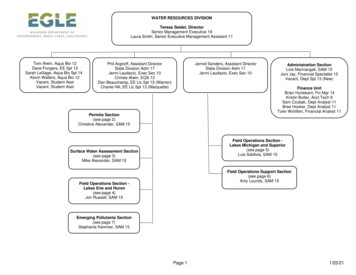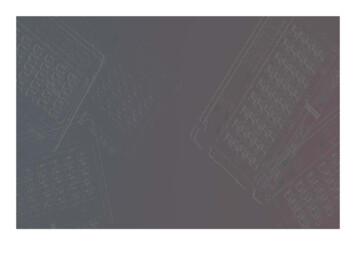Environmental Microbiology (BIO-224) General Course .
1Bergen Community CollegeDivision of Mathematics, Science, and TechnologyDepartment of Biology and HorticultureEnvironmental Microbiology (BIO-224)General Course SyllabusSpring2016Course Title:BIO 224 Environmental MicrobiologyCourse Description:This is a course concerning bacteria and other microorganisms and their role inthe environment. Topics will include an introduction to the main groups ofmicroorganisms and their physiology, soil microbiology, cycles of elements,aquatic microbiology, sewage treatment, bioremediation, and appliedmicrobiology encompassing food microbiology, industrial microbiology, andbiotechnology.Prerequisites:BIO 101 General Biology I, BIO 203 General Biology IIGeneral Ed Course:NoCourse Credit:4.0Hours per week:6.0: 3 hours lecture and 3 hours labCourse Coordinator:Luis JimenezRequired LectureTextbook:Environmental Microbiology, 3rd Edition, (Pepper, Gerba, Gentry), AcademicPress. Philadelphia, Pennsylvania, ISBN: 978-0123946263Supplementary Text:(Optional)Brock Biology of Microorganisms, 13th Edition, (Madigan,Martinko, Stahl, Clark),Benjamin Cummings Publishers, Upper Saddle River, New Jersey, ISBN: 9780321649638.Required LaboratoryManual:Environmental Microbiology, A Laboratory Manual, 2nd ed., (Pepper, Gerba, andBrendecke), Academic Press. Philadelphia, Pennsylvania, ISBN: ology Lab Manual, 2nd ed., (Bablanian and Payne), Kendall-Hunt, ISBN:978-0-7575-5789-7.Laboratory Materials:Students must wear protective eye wear and should purchase latex gloves andlaboratory coats.
2Student Learning Objectives:The student will be able to:1.Students will learn the major principles of environmental microbiology and the relationship ofmicrobes to environmental processes and other living organisms. Assessment will be basedupon performance on exam questions. Assessment can also be based on researchpapers/projects.2.Students will demonstrate proper scientific procedure to identify various type of environmentalmicrobes. Students will be evaluated by observation in the laboratory and analysis of unknownbacteria and projects. Assessment will also be based upon performance on exam question andlaboratory projects.3.Students will be able to explain the scientific basis for each technique used. Students will berequired to answer exam questions designed to allow them to demonstrate their acquisition andretention of this knowledge.4.Students will demonstrate proper scientific laboratory record keeping. Students will beevaluated by periodic notebook collection.5.Students will learn to practice critical thinking skills and apply them to both material presented inlecture and the analysis of data generated in the laboratory. Students will be evaluated byobservation in the laboratory and analysis of experimental results. Assessment will also bebased upon performance on exam questions.6.Students will use the scientific method of inquiry, through the acquisition of scientific knowledge.7.Students will use computer systems or other appropriate forms of technology to achieveeducational and personal goals.Student Assessment Tools:The above student learning objectives will be generally assessed or evaluated by instructors using a variety ofassessment instruments including lecture exams, laboratory exams, quizzes, laboratory reports, written reports,presentations, projects, etc. The decisions concerning the type or types and number of instruments that are used in aspecific section of the course will be left to the instructor of that section. This information, when given by the instructorshould be recorded by the student in the Student Assessment Section of this document.Course ContentLecture Topics:ChapterTitleText: Environmental Microbiology, 3rd Edition,Week 1Chapter 1Introduction to Environmental MicrobiologyA. Environmental Microbiology as a Discipline.B. Microbial Influences on our Daily Lives.Chapter 2Microorganisms Found in the EnvironmentA. Classification of Organisms.B. Prokaryotes.C. Eukaryotes.D. Viruses.E. Other Biological Entities.
3Week 2Chapter 3Bacterial GrowthA. Growth in Pure Cultures in a Flask.B. Continuous Cultures.C. Growth in the Environment.Week 3Chapter 4Earth EnvironmentsA. Earth’s Living Skin.B. Physiochemical Characteristics of the Earth Environment.C. Soil as a Microbial Environment.D. Microorganisms in Surface Soils.E. Distribution of Microorganisms in Soil.F. Microorganisms in Subsurface Environments.Week 4Chapter 5AeromicrobiologyA. Aerosols.B. Nature of Bioaerosols.C. Aeromicrobiology Pathway.D. Microbial Survival in the Air.E. Extramural Aeromicrobiology.F. Intramural Microbiology.Week 5Chapter 6Aquatic EnvironmentsA. Microbial Habitats in the Aquatic Environment.B. Microbial Lifestyles in Aquatic Environments.C. Marine Environments.D. Freshwater Environments.E. Other Notable Aquatic Environments.Week 6Chapter 7Extreme EnvironmentsA. Low Temperature Environments.B. High Temperature Environments.C. Desiccation and UV Stress.D. Aphotic Environments Based on Chemolithoautotrophy.Week 7Chapter 8Environmental Sample Collection and ProcessingA. Soils and Sediments.B. Water.C. Air.D. Detection of Microorganisms on Fomites.Chapter 9Microscopic TechniquesA. Visible Light Microscopy.B. Fluorescence Microscopy.
4C. Electron Microscopy.Week 8Chapter 10Cultural MethodsA. Extraction and Isolation Techniques.B. Plating Methods.C. Culture Media for Bacteria.D. Culture Methods for Algae and Cyanobacteria.E. Cell Culture-Based Methods for Viruses.Chapter 11Physiological MethodsA. Measuring Microbial Activity in Pure Culture.B. Choosing the Appropriate Activity Measurement for Environmental Samples.C. Carbon Respiration.D. Incorporation of Radiolabeled Tracers into Cellular Macromolecules.E. Adenylate Energy Charge.F. Enzyme Assays.Week 9Chapter 12Immunological MethodsA. What is an Antibody?B. Immunoassays.C. Immunosensors.Chapter 13Nucleic Acid-Based MethodsA. Structure and Complementarity of Nucleic Acids.B. Obtaining Microbial Nucleic Acids from the Environment.C. Hybridization-Based Assays.D. Amplification-Based Assays.E. DNA Fingerprinting.F. Recombinant DNA Techniques.G. Sequence Analysis.Week 10Chapter 16Biogeochemical CyclingA. Carbon Cycle.B. Nitrogen Cycle.C. Sulfur Cycle.D. Iron Cycle.Week 11Chapter 17Microorganisms and Organic PollutantsA. The Overall Process of Biodegradation.B. Contaminant Structure, Toxicity, and Biodegradability.C. Environmental Factors Affecting Biodegradation.D. Biodegradation of Organic Pollutants.E. Bioremediation.Chapter 18Microorganisms and Metal PollutantsA. Metals in the Environment.B. Metal Solubility, Bioavailability, and Speciation.C. Metal Effects on the Microbial Cell.
5D. Mechanisms of Microbial Metal Resistance and Detoxification.E. Microbial Metal Transformations.F. Microbial Approaches in the Remediation of Metal-Contaminated Environments.Week 12 and 13Chapter 19Microbial Diversity and Interactions in Natural EcosystemsA. Microbial Diversity in Natural Systems.B. Microbial Interactions.C. Microbial Diversity and Natural Products.Week 14Chapter 23Indicator MicroorganismsA. Total Coliforms.B. Fecal Coliforms and Escherichia coli.C. Fecal Enterococci.D. Clostridium perfringes.E. Bacteroides and Bifidobacterium.F. Heterotrophic Plate Count.G. Bacteriophages.Chapters 25, 28Municipal Wastewater Treatment, Drinking Water TreatmentA. The Nature of Wastewater.B. Conventional Wastewater Treatment.C. Oxidation Pools.D. Septic Tanks.E. Wetlands Systems.F. Sludge Processing.Week 15-FINAL EXAM
6Laboratory Schedule:Text: Env. Micro., A Laboratory Manual, 2nd Ed.WeekTitle1Introduction to the Lab, AsepticTechniques,Cultural Characteristics Of Bacteria,Environmental Sampling2Microscopic TechniquesPrep and Care of Stock Cultures3Cultural and Physiological Methods4Soil Microbiology5Air Microbiology6Water Microbiology7DNA Extraction8Amplification of Bacterial 16S rRNA Genes9Amplification of Functional Microbial Genes10Gel Electrophoresis11Sequencing of Bacterial 16S rRNA andFunctional Genes12Composting and Thermophilic Bacteria13Bioremediation14Lab Project15Lab Final and PresentationStudent Assessment:Lecture Examinations%Laboratory Component%Student Project/Report%Class Participation%Other%Total100%
7If you have a medical condition or develop a medical condition during this semester, which prevents you fromfulfilling the requirements of this course, you must notify your physician. You and your physician must decidewhether or not it is appropriate for you to remain in this course. If the decision is to remain in this course, pleaseobtain a letter from your physician indicating that your continued participation in this course is appropriate andpresent it to the Department Chair.Faculty Addenda: As per individual faculty memberLecture Attendance: As per instructor;Lab Attendance: As per instructor;Policy Concerning Late Assignments: As per instructor;Policy Concerning Make-Up Testing: As per instructor;Safety Information: As per instructor and assigned exercise;College Policies:Student ResponsibilityStudents will be held responsible for reading all pertinent information in college publications regarding withdrawals, coursedrops, college deadlines, and tuition refunds. Students are responsible for compliance with the rules and regulations asstated in college publications.Absence of InstructorStudents are expected to wait twenty minutes for a faculty member to come to class. If at the end of twenty minutes, thefaculty member does not come, the students should sign an attendance sheet, which indicates the course, date, andtime. A student should deliver the attendance sheet to the divisional office (A304) if between 9:00 a.m. and 5:00 p.m. orto the Evening Office (C107) if before 9:00 a.m. or after 5:00 p.m. Students cannot be penalized by faculty for notwaiting longer than twenty minutes.Academic Dishonesty and PlagiarismBergen Community College is committed to academic integrity – the honest, fair and continuing pursuit of knowledge,free from fraud or deception. Students are responsible for their own work. Faculty and academic support services staffwill take appropriate measures to discourage academic dishonesty. Plagiarism is a form of academic dishonesty andmay be a violation of U.S. Copyright laws. Plagiarism is defined as the act of taking someone else’s words, opinions, orideas and claiming them as one’s own.
8Consequences of Violations Academic IntegrityA. Instructor’s Sanctions for a ViolationThe faculty member will determine the course of action to be followed. This may include: Assigning a failing grade on the assignment; Assigning a lower final course grade; Failing the student in the course Other penalties appropriate to the violation;In all cases, the instructor shall notify the Vice President of Student Services of the violation and the penaltyimposed. The student has the right to appeal the decision of the instructor to the appropriate department head.B. Institutional Sanctions for ViolationsWhen a violation of academic integrity has been reported regarding a student, the Vice President of StudentServices may impose disciplinary penalties beyond those imposed by the course instructor, which may includesuspension or dismissal from the College. The student shall have the right to a hearing before the Vice President ofStudent Services or a designated judicial affairs committee. Judicial procedures governing violations of academicintegrity are contained in the student handbook.Class AttendanceAll students are expected to attend punctually every scheduled meeting of each course in which they are registered.Attendance and lateness policies and sanctions are to be determined by the instructor for each section of each course.These will be established in writing on the individual course outline. Attendance will be kept by the instructor foradministrative and counseling purposes.Eating and DrinkingEating or drinking in classrooms, lecture rooms, laboratories, gymnasium, swimming pool, or passageways is forbidden.Covered beverages only are permitted in the library. Eating and drinking are permitted in cafeteria and vending areasonly.Learning AssistanceHenry and Edith Cerullo Learning Assistance CenterThe Tutoring Center, English Language Resource Center, Math Walk-In Center and Writing Center are collectivelyknown as the Henry and Edith Cerullo Learning Assistance Center. The Cerullo Learning Assistance Center is locatedin the Pitkin Education Building, in Room L-125. The telephone number is (201) 447-7489. The Learning AssistanceCenter, staffed with peer and professional tutors, offers free individual and group tutoring, supplemental instruction, andonline tutoring for subjects offered at the College. The Center provides alternative approaches to problem solving andorganizational skills. Tutors help clarify classroom lectures and textbooks and help students prepare for exams. Theseservices build student self-confidence and reduce fear of failure. The Center is equipped with the latest technology andsoftware, including tapes, books, review sheets, exercises and software.Services for Students with DisabilitiesBergen Community College aims to create inclusive learning environments where all students have maximumopportunities for success. Any student who feels he or she may need an accommodation based on the impact of adisability should contact the Office of Specialized Services at 201-612-5269 or via email at ossinfo@bergen.edu forassistance.Sidney Silverman LibraryMain Building, Pitkin Education Center, L-wing, 2nd Floor.Paramus Library Hours: (201) 447-7131 or visit amus Service Desk: (201) 447-7970Meadowlands Location: 1280 Wall Street, Lyndhurst 2nd FloorMeadowlands Library Hours: dowlands Service Desk: (201) 301-9692www.bergen.edu/library
9Testing ServicesThe Bergen Community College Office of Testing Se
Week Title Text: Env. Micro., A Laboratory Manual, 2nd Ed. 1 Introduction to the Lab, Aseptic Techniques, Cultural Characteristics Of Bacteria, Environmental Sampling 2 Microscopic Techniques Prep and Care of Stock Cultures 3 Cultural and Physiological Methods 4 Soil Microbiology 5 Air Microbiology 6 Water Microbiology 7 DNA Extraction
159386 BIO BIO 301 Biotechnology and Society 158405 BIO BIO 202 Microbiology and Immunology 158396 BIO BIO 304 Ecology of Place 159428 BIO BIO 300 Population, Resources and Environment 159430 BIO ENS 110 Populations, Resources and Environment 151999 ENG ENG 340 Global British Literature
Dawn Roush, Env Mgr 14 Kevin Goodwin, Aqua Bio Spl 13 Bill Keiper, Aqua Bio Spl 13 Sam Noffke, Aqua Bio 12 Lee Schoen, Aqua Bio 11 Elizabeth Stieber, Aqua Bio 11 Kelly Turek, Aqua Bio 12 Chris Vandenberg, EQA 11 Jeff Varricchione, Aqua Bio 12 Matt Wesener, Aqua Bio 11 Marcy Knoll Wilmes, Aqua Bio Spl 13
An Introduction to Clinical Microbiology Susan M. Poutanen, MD, MPH, FRCPC . Objectives 1. To provide an introduction to a typical microbiology laboratory 2. To address specific microbiology laboratory test issues as they apply to public health. Department of Microbiology Who we are Shared microbiology service between TML (UHN & MDS) and MSH
Industrial microbiology Medical and pharmaceutical microbiology Rumen microbiology Space microbiology 1.2 Definitions Milk and milk products occupy a more significant role in the human food profiles. The study of microorganisms that are associated with milk and milk products in all aspects is defined as "Dairy Microbiology". 1.2 .
General Microbiology Manual _ Abdelraouf A. Elmanama Ph. D Microbiology 7 Introduction Welcome to the microbiology laboratory. The goal of the laboratory is to expose students to the wide variety of lives in the microbial world. Although the study of microbiology includes
Microbiology H Core 4 3 30 70 100 4 MBH- 204 Food Microbiology H Core 4 3 30 70 100 4 MBS- 205 Bioinformatics S Core 2 2 15 35 50 2 Practical MBP- 206 Microbial Genetics, Molecular Biology Pract 4 4 30 70 100 4 MBP- 207 Environmental Microbiology and Food Microbiology Pract 4 4 30 70 100 4
AlphaGuard BIO The AlphaGuard BIO System is a liquid-applied, bio-based, two-component, polyurethane roof restoration system. The development of AlphaGuard BIO is derived from unique bio-based, polyurethane technology. The high bio-content makes for a sustainable, environmentally responsible roofing product while
Peninsula School District School Improvement Worksheet. version 1.0 . ELA SMART Goal Worksheet 2015-16 School: DISCOVERY ELEMENTARY Team: ELA Leaders: ALL The primary focus of our work is for all students to meet or exceed rigorous standards.























